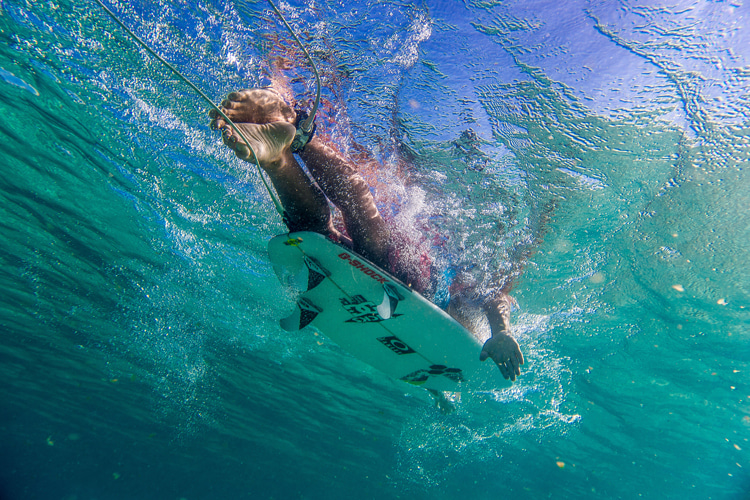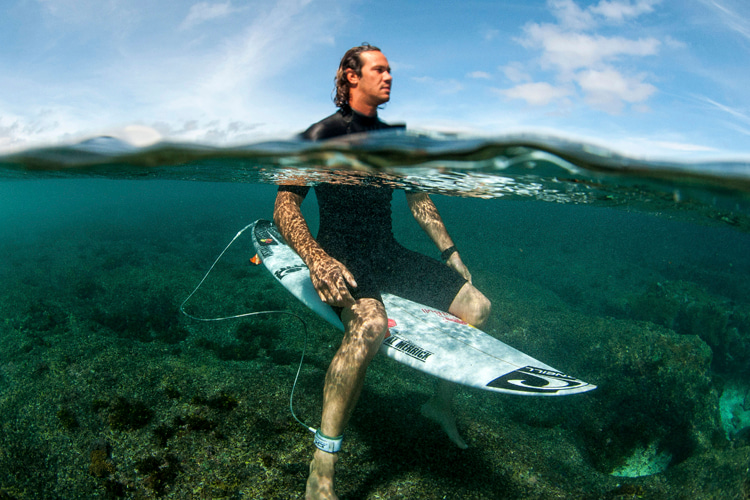Surf leash tangles can be frustrating and even dangerous when riding waves, as they can cause you to lose control of your surfboard. Here's how to prevent it from happening.
Leashes are one of the most useful pieces of surfing equipment.
They keep you close to your board and prevent it from hitting fellow surfers. They also ensure you don't have to swim to the beach to retrieve your board and help you resurface in extreme conditions.
The legrope is a mandatory item in the lineup, but it can also ruin a perfect ride.
How many good-looking waves have you failed to surf to the end because of an annoying tangled leash? Probably a few times.
It happens more than it should across all riding moments: during the take-off, popping up, the bottom turn, and while turning, carving, and cutting back.
And if you're a longboarder, you have certainly got tangled up while cross-stepping on your way to a hang ten.
So, what can surfers do to avoid getting leashes wrapped around their ankles and legs all the time?
Here are some tips to prevent surf leash loops:

1. Get the Right Leash Length
Make sure your leash is long enough to allow you to move around on your board without getting tangled, but not so long that it drags in the water and catches on kelp or other obstacles.
The rule of thumb is a six-foot legrope for a six-foot surfboard.
2. Consider Using a Comp Leash
It's lighter and thinner and tends to coil less than regular legropes.
Moreover, it created less drag.
3. Choose a Leash With a Sturdy Swivel
A swivel is a small device that attaches to your leash cuff and allows it to rotate freely.
It can help prevent tangles by enabling it to move independently of the board.
4. Keep Your Leash Straight
Before paddling out, ensure your leash is straight and not wrapped around your board or leg.
Then, if necessary, pull it a few times for a minute until it gets relatively straightened out - before and after the session.
5. Adjust the Strap/Cuff
When putting the leash on, keep the swivel and the urethane cord facing backward on your ankle and pointing toward the tail of the board.
6. Be Mindful of Your Movements
Before paddling into and after riding a wave, double-check the cuff/strap and make adjustments to make sure it's put on correctly.
7. Do Not Wrap the Surfboard Leash Around the Fins
To avoid tangles in your surf leash, it's important not to wrap it around your board.
While this might seem like a good idea, it can actually put kinks in the leash and cause it to tangle more easily.
The material that the leash is made of has a memory and will try to coil around your leg if it's wrapped around your board.
So, leaving your leash free when you store your board is always a better option. While it might not be as convenient, it will help prevent tangles.
8. Rinse It
After every surf session, clean your legrope with fresh water and ensure sand, salt, and wax are removed.
9. Take It Off
Remember to take the leash off your board after each session. Don't leave it wrapped around the fins and inside the travel bag.
10. Hang It
To avoid future loops, keep it hung somewhere at your place, for instance, in the storage room, garage, or even closet.
Conclusion
Although it sometimes seems true, leashes are not all the same.
While the urethane cord itself might vary little, the connection to the ankle strap differs significantly from inexpensive to quality leashes.
Ideally, you want a leash that keeps away from your leg, creating a space that prevents it from getting tangled around your feet.
And that is only possible when the urethane cord immediately after the swivel is thicker and less prone to flexibility.
Bodyboarders and stand-up paddleboarders often use coiled leashes. However, surfers have never quite adopted it.
